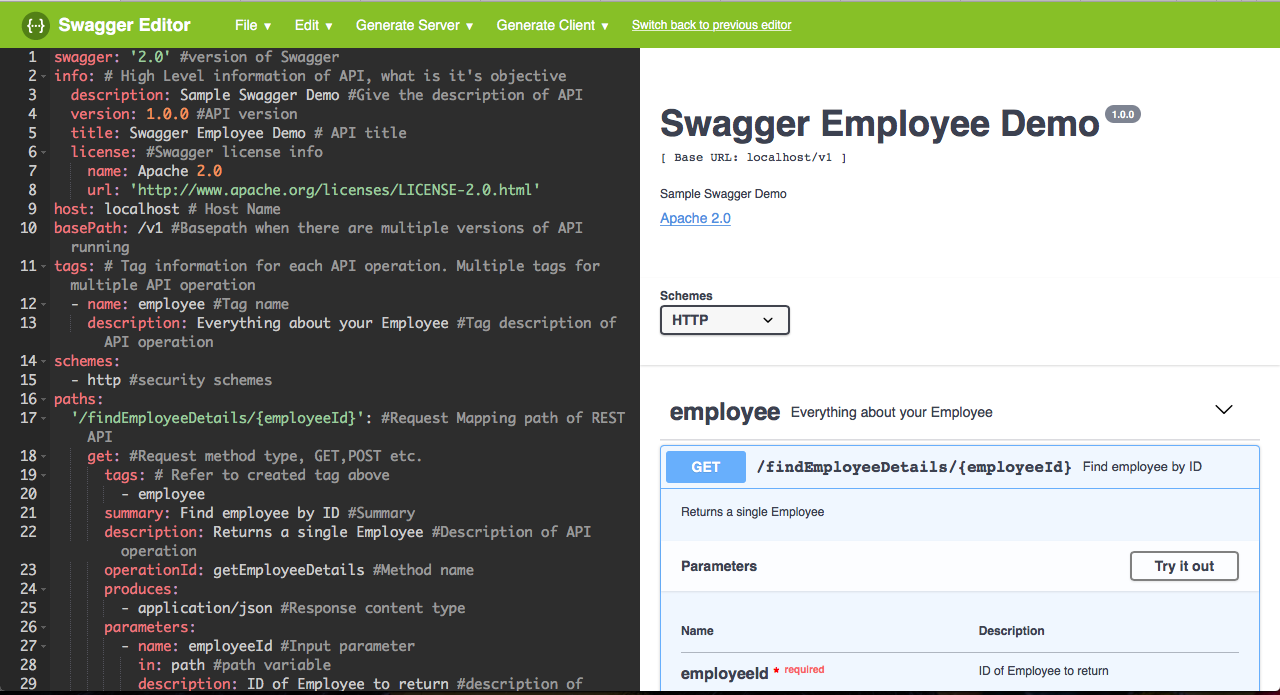
- Swagger editor definition how to#
- Swagger editor definition software#
- Swagger editor definition code#
Swagger editor definition software#
Swagger documents can be processed by various programming languages and can be checked into source control for version management during the software development cycle.īut Swagger has shortcomings of its own. The framework provides the OpenAPI Specification (formerly known as the Swagger specification) for creating RESTful API documentation formatted in JSON or YAML, a human-friendly superset of JSON. The open source Swagger framework helps remedy these issues for API consumers and developers. Those types of documents are also harder to integrate into an automated testing application. Those formats can make collaboration and document version control difficult, especially for applications that have many APIs or resources, or when APIs are under iterative development.

Without an adequate contract service, many REST API providers use Microsoft Word documents or wiki pages to document API usage.

class ProductController ", method = RequestMethod.Most web applications support RESTful APIs, but - unlike SOAP APIs - REST APIs rely on HTTP methods and lack a Web Services Description Language (WSDL) equivalent to define request and response structures between consumers and providers. The controller of the application, ProductController, defines the REST API endpoints. The Maven POM of the application is this. The service layer is composed of a ProductService interface and a ProductServiceImpl implementation class. We have a Product JPA entity and a repository named ProductRepository that extends CrudRepository to perform CRUD operations on products against an in-memory H2 database. Our application implements a set of REST endpoints to manage products.
Swagger editor definition code#
The code to include Swagger UI is this.īecome a Spring Framework Guru with my Spring Framework 5: Beginner to Guru Online Course! The Spring Boot RESTful Application In addition to Springfox, we also require Swagger UI. To bring it in, we need the following dependency declaration in our Maven POM. We will be using Springfox in our project. Springfox supports both Swagger 1.2 and 2.0.

Currently, Springfox, that has replaced Swagger-SpringMVC (Swagger 1.2 and older), is popular for Spring Boot applications. The Swagger 2 specification, which is known as OpenAPI specification, has several implementations. Besides rendering documentation, Swagger UI allows other API developers or consumers to interact with the API’s resources without having any of the implementation logic in place. These files are bundled by the Swagger UI project to display the API on browser. The current version defines a set HTML, JavaScript, and CSS assets to dynamically generate documentation from a Swagger-compliant API. It is language-agnostic and is extensible into new technologies and protocols beyond HTTP. Swagger 2 is an open source project used to describe and document RESTful APIs.
Swagger editor definition how to#
In this post, I’ll cover how to use Swagger 2 to generate REST API documentation for a Spring Boot 2.0 project. For best practices on documentation, I suggest going through this presentation by Andy Wikinson. I won’t be covering it here in this post. However, the best practices on how you document your API, its structure, what to include and what not, are altogether a different subject. Thus your API documentation becomes more critical.ĪPI documentation should be structured so that it’s informative, succinct, and easy to read. However, with RESTFul web services, there is no WSDL. This gave API developers a XML based contract, which defined the API. In SOAP based web services, you had a WSDL to work with. Your clients will need to know how to interact with your API. You now have clients which will now be using your API. The Spring Boot makes developing RESTful services ridiculously easy, and using Swagger makes documenting your RESTful services much easier.īuilding a back-end API layer introduces a whole new area of challenges that goes beyond implementing just endpoints.


 0 kommentar(er)
0 kommentar(er)
